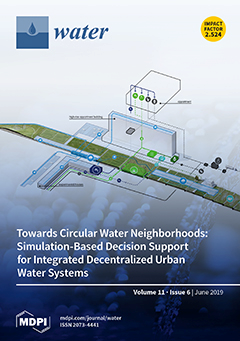Knowledge of both state (e.g., soil moisture) and flux (e.g., actual evapotranspiration (
ETa) and groundwater recharge (
GR)) hydrological variables across vadose zones is critical for understanding ecohydrological and land-surface processes. In this study, a one-dimensional process-based vadose zone
[...] Read more.
Knowledge of both state (e.g., soil moisture) and flux (e.g., actual evapotranspiration (
ETa) and groundwater recharge (
GR)) hydrological variables across vadose zones is critical for understanding ecohydrological and land-surface processes. In this study, a one-dimensional process-based vadose zone model with generated soil hydraulic parameters was utilized to simulate soil moisture,
ETa, and
GR. Daily hydrometeorological data were obtained from different climate zones to drive the vadose zone model. On the basis of the field phenomenon of soil moisture temporal stability, reasonable soil moisture spatiotemporal structures were reproduced from the model. The modeling results further showed that the dependence of
ETa and
GR on soil hydraulic properties varied considerably with climatic conditions. In particular, the controls of soil hydraulic properties on
ETa and
GR greatly weakened at the site with an arid climate. In contrast, the distribution of mean relative difference (
MRD) of soil moisture was still significantly correlated with soil hydraulic properties (most notably residual soil moisture content) under arid climatic conditions. As such, the correlations of
MRD with
ETa and
GR differed across different climate regimes. In addition, the simulation results revealed that samples with average moisture conditions did not necessarily produce average values of
ETa and
GR (and vice versa), especially under wet climatic conditions. The loose connection between average state and flux hydrological variables across vadose zones is partly because of the high non-linearity of subsurface processes, which leads to the complex interactions of soil moisture,
ETa, and
GR with soil hydraulic properties. This study underscores the importance of using soil moisture information from multiple sites for inferring areal average values of
ETa and
GR, even with the knowledge of representative sites that can be used to monitor areal average moisture conditions.
Full article





